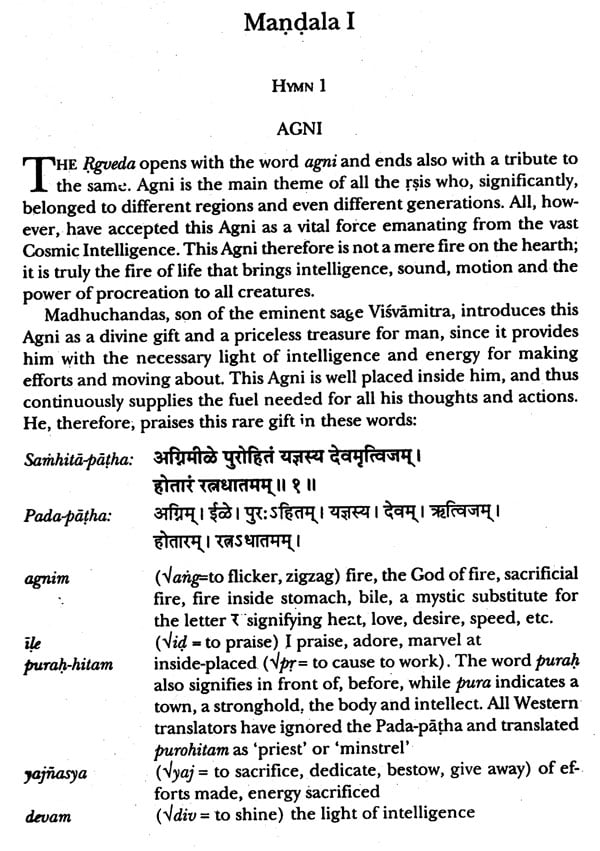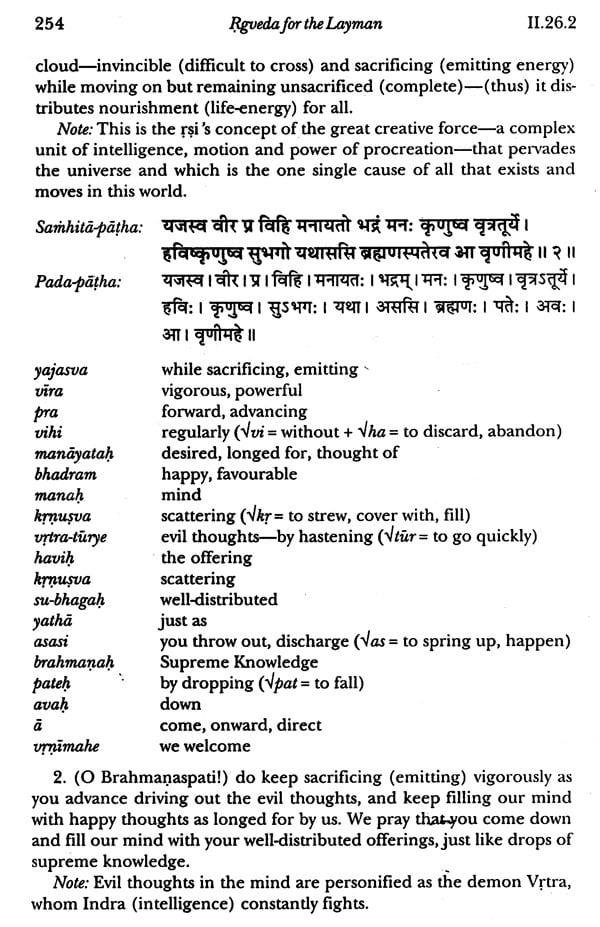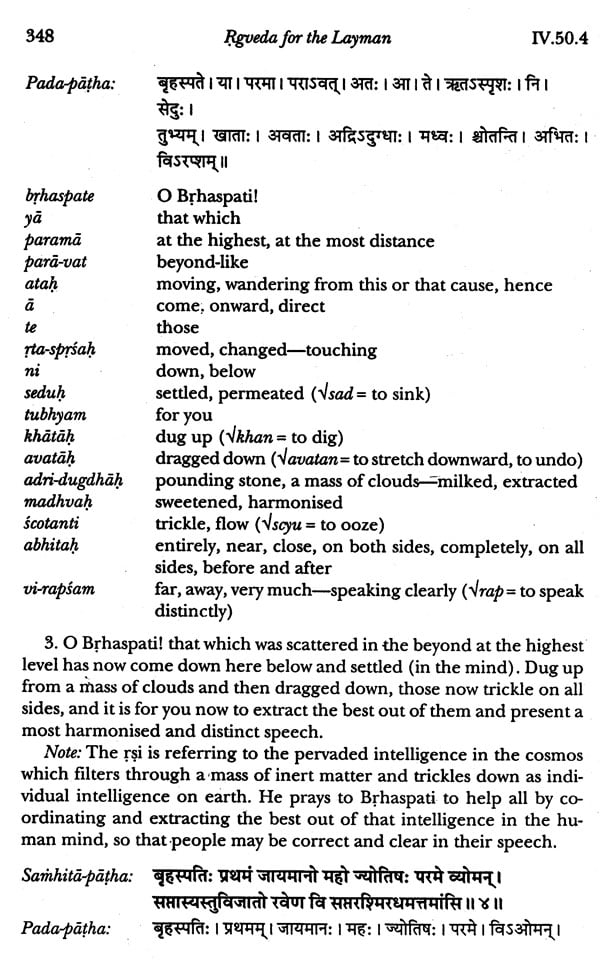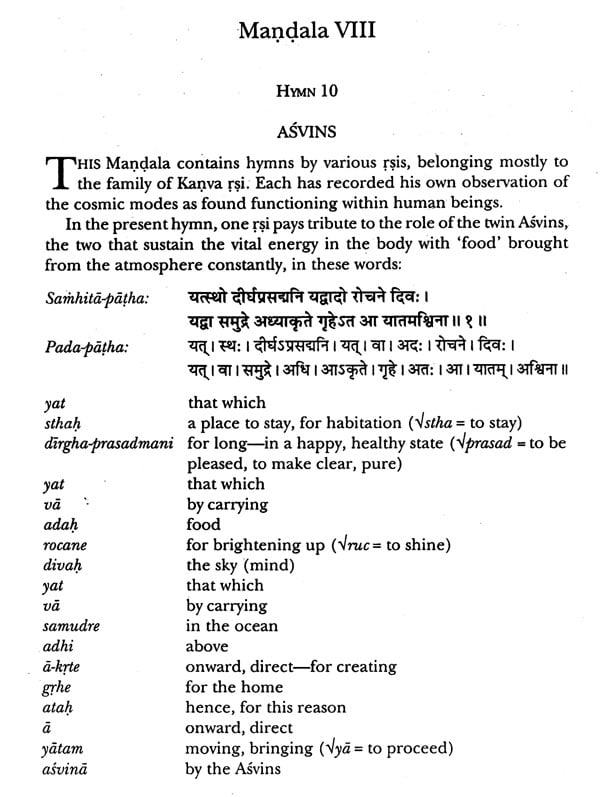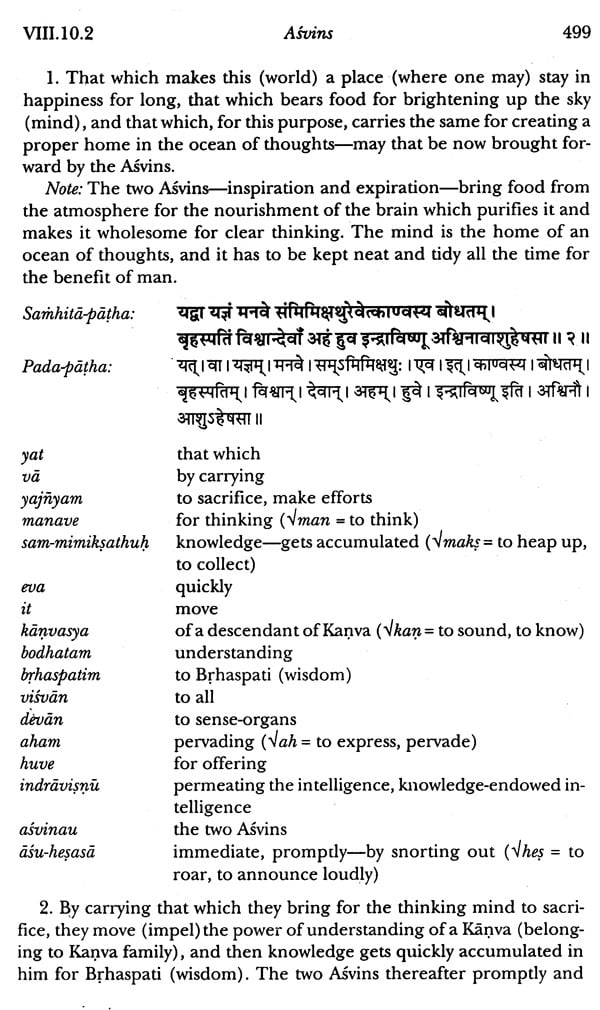
Rgveda for the Layman: A Critical Survey of One Hundred Hymns of the Rig Veda
Book Specification
| Item Code: | IDC843 |
| Author: | Shyam Ghosh |
| Publisher: | MUNSHIRAM MANOHARLAL PUBLISHERS PVT LTD |
| Language: | English |
| Edition: | 2014 |
| ISBN: | 9788121510431 |
| Pages: | 889 |
| Cover: | Hardcover |
| Other Details | 6.6" x 10.2" |
| Weight | 1.12 kg |
Book Description
This book provides a complete view of the world’s most ancient scripture the Rgveda. Here each Vedic word which at first sight appears cryptic and mysterious has been explained in lucid terms after analyzing it down to its root and sound so that the real intention of the rsi who compiled the hymn is made clear.
Those readers who are interested in the real ethos of our first book of knowledge on which is based our Hindu dharma and culture will find this sample survey of one hundred hymns most engrossing and helpful in understanding the whole ethos of the Vedas.
Shyman Ghosh (1904-2000) was a Vedic research scholar. He had studied other Hindu scriptures as well some of which he had translated and published including an exhaustive commentary on Patanjali’s yogasutra.
Having boycotted his school at the call of Mahatma Gandhi in 1920 Shyamn Ghosh joined Freedom Movement and participated in meetings and the rallies organized by Pt. Jawaharlal Nehru and other leaders. Later after a few years of self education he worked his way to the editorial staff of three national daily newspaper before being selected as the editor of the Air journals the Indian listener awaz and sarang.
After a few years he was shifted to the publication division of the same ministry as Deputy director and then on to the finance ministry where he worked as financial advisor to the director general of supply and disposal.
He had always been averse to personal publicity. An author should be judged by his work and not by his personal qualifications was his firm view.
Some of his other works are. The original Yoga (1980-1999) and Hindu Concept of life and death (1989-2002).
Fresh translation and reinterpretation of Rgveda hymns is now essential for two main reasons. First, because the existing translations, having missed the true Vedic ethos, present only a distorted view of the highly subtle thoughts of those early thinkers. Second, the misconceptions created by those misinterpretations are still producing wide- spread revulsion and ridicule, both among the lay and the learned.
To cite only two examples: One distinguished orient list of the West, while translating some of the hymns, expressed his disgust in these words.
There are hymns in the Rgveda which make me shiver when I am asked to look upon them as representing the thought and language of our humanity three thousand years ago. . . In the Vedic literature we find nothing corresponding to the Ten Commandments.
Then, almost a century later, an eminent Indian (evidently not a Vedic scholar himself but fed on some garbled versions of these hymns) reacted with these words:
The Vedas are a worthless set of books. There is no need to call these sacred and infallible; nobody has the courage to ask why these worthless books, which contain nothing but invocations to tribal gods to destroy enemies and loot their property and give it to their followers, have been made sacred and infallible.
Evidently, much misconception prevails about the true 4ieda, both in East and the West. Tribal gods invoked to destroy enemies is, of course, the tenor of all translations made in the West. This picture, along with fanciful accounts of fire-worship, soma drinking, gambling and even incest, are still being propagated all over the world as “proofs” of a primitive culture we all are supposed to have inherited.
Unfortunately, the mischief has not yet been rebutted by any Vedic scholar in India so far, although a mischief it is no doubt since these denigrating accounts are found suitably mixed with a few nobler thoughts also claimed to have been discovered by the same translators.
However, in their defense it must be conceded that all the early translators toiled under a serious handicap, because this Veda had never been translated into another language for well over 3,000 years and its language had already turned archaic. Also, no lexicon or grammar then existed which could help in deciphering the true sense of many words used figuratively. Only commentaries, illustrated with allegories and objective similar, were available, along with some metaphysical concepts as found expounded in later scriptures. All these proved insufficient for fully comprehending the true concept of Vedic thoughts as recorded in our earliest Book of Knowledge.
Another factor that might have, or perhaps surely did impinge upon their work was the time when it was undertaken. For that particular period of history happened to be the heyday of colonialism when most European nations were busy subjugating the less fortunate people all over the world. The atmosphere then was well defiled by race consciousness and an arrogance born of the new triumphs of Industrial Revolution in the West.
In addition, there was of course the moral pressure from proselytizing missionaries, who naturally looked for the actual basis of earlier beliefs of those whom they wished to convert to their own faith. The Government of the day too seemed equally interested, as is proved by the fact that the very first translation of the Rgveda into English was liberally financed by the East India Company and, when published, was ceremonially presented to the Queen Empress of Great Britain—evidently to celebrate a significant break through in understanding the mind of a subject people believed to be in dire need of political and moral Lessons.
But times have changed now. it is essential therefore that the elite in both East and West should now revise their old views and prejudices. They must realize that the modern layman, brought up in a science- oriented atmosphere (and hence much more rational and unprejudiced than his early predecessors) can no longer be duped with fairy tales and corrupt history. He actually awaits to have a fresh look at our priceless heritage.
For various reasons the present translation is restricted to one hundred hymns only. This is, therefore, in the nature of a sample survey, intended to give the general reader a glimpse of the sublime thoughts conserved in this scripture. The modern scientist too would now find that all the basic laws of physics, including the event of the Rig-Bang and the unified field of electro-magnetism (which Einstein viasualized and which modern physicists are still investigating) have their foundation well laid down in our First Book of Knowledge, In order to present a clearer picture of the Vedic ethos, therefore, the hymns now translated have been fully analyzed word by word. The root and sound of each letter have been traced back to their origin, so as to clarify all possible implications of each word uttered by the r1t For, as the old glossopgraher Yaska said no mantra can be fully comprehended unless the root and sound of each word are correctly identified.
In the Rgveda there are 10,28 hymns with a total of 10,552 verses spread over 10 mandalas. Thus the present translation constitutes less than one twentieth of the entire work. The remaining hymns are of course of equal importance. It is hoped therefore that some other scholar would continue the work and complete the translation of all the remaining hymns for the benefit of the modern layman.
To know all is a natural urge in every human being. But to know anything truly and completely needs special efforts. This is because the first impressions are not always correct, and repeated assessment of the same is therefore necessary to confirm the truth. The highest knowledge then leads to Reality.
Thus, man’s quest for more and more knowledge has continued since time immemorial. Man has even stepped into the Beyond in order to find out how and why he came into being, the purpose of his existence on earth, and the cause of its short duration here. Also, what next? Apparently, his search ceases only when he has himself discovered the Ultimate Cause.
At least such were his earliest thoughts as we now find conserved in the Rgveda. This Veda is today universally recognized as the earliest extant scripture of mankind. It has been translated now in several modern languages and its contents interpreted by eminent scholars. The consensus, however, is that the thoughts expressed in its hymns are primitive in nature and only indicate an immature state of civilization in those days.
On the other hand, a vast number of people belonging to this age still regard this Veda as a scared Book of Knowledge and the source perhaps of all existing religions. They adore it as their priceless heritage and freely quote from it in support of their own noble thoughts and actions.
What, then, is the truth? The modern layman, brought up as he is in an age of science and technology, finds it difficult to reconcile the two opposite views. He is puzzled. If this Veda is indeed offering only primitive thoughts and practices, why is it being still adored? Why this chanting of mantras at all social functions? The answer perhaps can be found in the Rgveda itself.
As is now well-known, the Rgveda originated in the minds of some early free-thinkers who then expressed their thoughts in the form of hymns. The hymns were presumably sung at small gatherings and, script being unknown at that time, these were carried in memory and later passed down from generation to generation. When writing became viable, the same hymns were compiled and scripted to form one large volume of 1028 hymns, distributed into ten sections or mandalas. This single volume now exceeds the combined length of the Odyssey and the Iliad.
Surprisingly, the earliest scripture of mankind remained untranslated in any language of the world for well over 3,000 years. It was kept hidden, it is said, by some high class Brahmins who did not permit any non Brahmin even to look at it!
Then, early in the nineteenth century of this era, a copy of the original manuscript somehow found its way to the West. There a few orient lists got interested in its contents; they mastered the Sanskrit grammar of Panini, prepared a German lexicon of its words, and thereafter labored hard to interpret the archaic language of the hymns. Then, in 1838, appeared for the first time a partly translated version of the Rgveda in Latin, to be followed later by similar others in German and English languages.
However, none of these translations reflected the true ethos of Vedic thinking. Evidently, the terse and figurative language of the hymns completely confounded the translators, who got lost in the literal meaning of words they had themselves collected and interpreted. The result was a blaze of misinterpretations.
Another evident cause of Western misconception was their total dependence on later Indian scriptures. They at first took their cue from Säyananärya, a fourteenth-century savant, who had for the first time produced a commentary on all Rg hymns in classical Sanskrit but based entirely on the Brahmans. These later scriptures, as is well-known now, were produced several centuries after the compilation of the Rgveda and they only expounded the subtle Rg thoughts with allegories and similar, perhaps for the benefit of the layman of the day. In doing so, they naturally diluted the abstract thoughts of the rsis.
The total dependence of Western translators on these later scriptures has therefore now proved very unfortunate. It has led to widespread disinformation about mankind’s true cultural heritage. The Vedic age is now being portrayed as a period in prehistory when (according to them) savage and uncultured people inhabited this land, worshipped fire and natural phenomena, and indulged in the practice of many forms of sorcery and superstition. This view, surprisingly, is still being propagated in the West through scholarly’ discussions of many Brahmana tales.
| Preface | xi | ||
| Introduction | xiv | ||
| 1 | Knowing the Unknown | xiv | |
| 2 | The Concept | xix | |
| 3 | Thought Sound word | xxvi | |
| 4 | Prehistory and History | xxxiii | |
| 5 | The Decline and fall | xlvii | |
| 6 | Misconceptions Galore | liii | |
| 7 | Mud and Slush | lxiv | |
| 8 | The External Values | lxxi | |
| 9 | Future Scope Notes | lxxix | |
| Madala I | |||
| Hymn 1 | Agni | 1 | |
| Hymn 2 | Vayu | 7 | |
| Hymn 3 | Asvins/Indra | 13 | |
| Hymn 4 | Indra | 20 | |
| Hymn 5 | Indra | 27 | |
| Hymn 6 | Indra | 33 | |
| Hymn 7 | Indra | 39 | |
| Hymn 12 | Agni | 45 | |
| Hymn 15 | Tavas | 52 | |
| Hymn 19 | Maruts | 59 | |
| Hymn 20 | Rbhus | 64 | |
| Hymn 25 | Varuna | 69 | |
| Hymn 35 | Savita | 82 | |
| Hymn 43 | Rudra | 93 | |
| Hymn 59 | Visvanara | 99 | |
| Hymn 75 | Agni | 105 | |
| Hymn 85 | Maruts | 108 | |
| Hymn 90 | Visvedevah | 120 | |
| Hymn 99 | Jatavedas | 126 | |
| Hymn 115 | Surya | 128 | |
| Hymn 137 | Mitravaruna | 133 | |
| Hymn 143 | Apam napat | 137 | |
| Hymn 154 | Visnu | 145 | |
| Hymn 160 | Dyava prthivi | 152 | |
| Hymn 164 | Visvedevah | 157 | |
| Hymn 179 | Dampati | 207 | |
| Hymn 190 | Brhaspati | 213 | |
| Madala II | |||
| Hymn 1 | Agni | 222 | |
| Hymn 12 | Indra | 238 | |
| Hymn 26 | Brahamaspati | 252 | |
| Hymn 33 | Rudra | 257 | |
| Hymn 35 | Apam Napat | 270 | |
| Hymn 43 | Indra | 283 | |
| Madala III | |||
| Hymn 12 | Indragni | 288 | |
| Hymn 26 | Vaisvanara/Marut | 293 | |
| Hymn 45 | Indra | 300 | |
| Hymn 59 | Mitra | 305 | |
| Hymn 61 | Usas | 311 | |
| Hymn 62 | Indra Varuna | 317 | |
| Madala IV | |||
| Hymn 18 | Indra/Aditi | 330 | |
| Hymn 46 | Indra/Vayu | 342 | |
| Hymn 50 | Inra. Brhaspati | 346 | |
| Hymn 51 | Usas | 355 | |
| Hymn 54 | Savita | 365 | |
| Madala V | |||
| Hymn 11 | Agni | 371 | |
| Hymn 26 | Agni | 377 | |
| Hymn 39 | Indra | 382 | |
| Hymn 49 | Visvedevah | 382 | |
| Hymn 60 | Marutagni | 391 | |
| Hymn 83 | Parjanya | 398 | |
| Madala VI | |||
| Hymn 10 | Agni | 409 | |
| Hymn 20 | Indra | 415 | |
| Hymn 30 | Indra | 426 | |
| Hymn 42 | Indra | 431 | |
| Hymn 55 | Pusan | 433 | |
| Hymn 61 | Sarasvati | 437 | |
| Hymn 73 | Brhaspati | 446 | |
| Madala VII | |||
| Hymn 28 | Indra | 450 | |
| Hymn 49 | Apas | 455 | |
| Hymn 54 | Vastospati | 458 | |
| Hymn 63 | Surya | 461 | |
| Hymn 71 | Asvins | 466 | |
| Hymn 75 | Usas | 472 | |
| Hymn 86 | Varuna | 479 | |
| Hymn 102 | Parjanya | 486 | |
| Hymn 103 | Mandukah | 488 | |
| Madala VIII | |||
| Hymn 10 | Asvins | 498 | |
| Hymn 30 | Visvedevah | 503 | |
| Hymn 48 | Soma | 506 | |
| Hymn 58 | Visvedevah | 519 | |
| Hymn 79 | Soma | 522 | |
| Hymn 94 | Maruts | 528 | |
| Hymn 101 | Adityah | 535 | |
| Madala IX | |||
| Hymn 1 | Pavamana Soma | 548 | |
| Hymn 29 | Pavamana Soma | 554 | |
| Hymn 59 | Pavamana Soma | 557 | |
| Hymn 113 | Pavamana Soma | 560 | |
| Madala X | |||
| Hymn 10 | Yama Yami | 570 | |
| Hymn 14 | Yama | 584 | |
| Hymn 15 | Pitarah | 598 | |
| Hymn 18 | Mrtyu | 610 | |
| Hymn 34 | Aksah | 623 | |
| Hymn 54 | Indra | 637 | |
| Hymn 71 | Jnanam | 643 | |
| Hymn 84 | Manyu | 654 | |
| Hymn 90 | Purusa | 660 | |
| Hymn 119 | Atmastuti | 673 | |
| Hymn 121 | Kah | 681 | |
| Hymn 125 | Vagambhrni | 690 | |
| Hymn 127 | Ratri | 698 | |
| Hymn 129 | Srstih | 703 | |
| Hymn 135 | Yama | 710 | |
| Hymn 136 | Kesin | 715 | |
| Hymn 151 | Sraddha | 720 | |
| Hymn 170 | Suryah | 723 | |
| Hymn 176 | Rbhu | 727 | |
| Hymn 185 | Aditi | 731 | |
| Hymn 189 | Suryah | 733 | |
| Hymn 190 | Srstih | 735 | |
| Hymn 191 | Agni | 738 | |
| Glossary | 742 |
